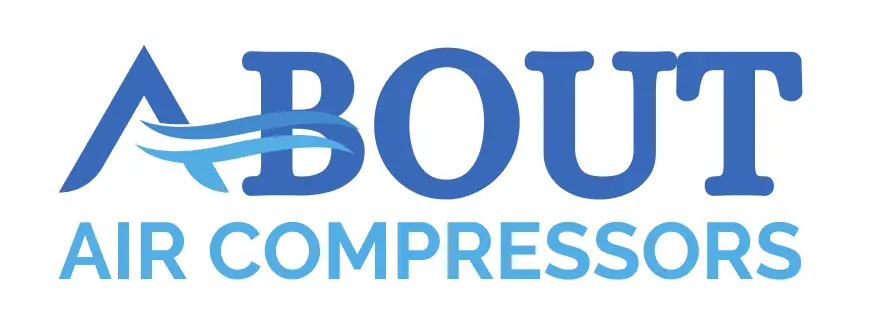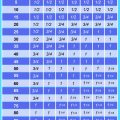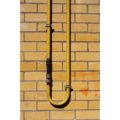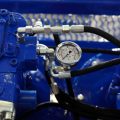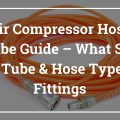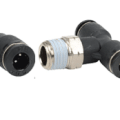Hey! This site is reader-supported and we earn commissions if you purchase products from retailers after clicking on a link from our site.
What air lines should be used and how big they should be to properly plumb air from the compressor to the use area is the subject of many of the questions that visitors to this site ask.
What the flow capacity of the various sizes of hose, the tubing or piping to supply compressed air to their air tools and air using applications and so on.
How to connect an air line is a popular question as well. This page focuses on the flow capabilities of air lines in general, and how the distance from the air compressor to the air tool impacts the air-using equipment’s capabilities.
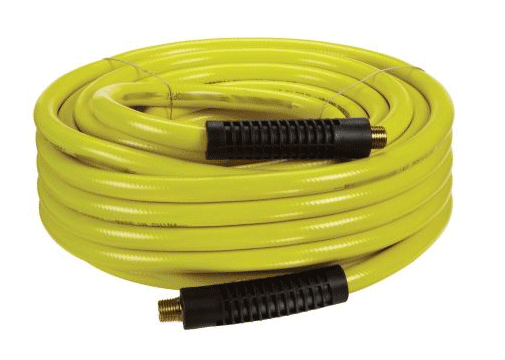
Other pages on this site talk about other air line and air hose specifics. A couple of those pages are the pages about Air Hose and those about Air Tube. Check them out for more info about these two methods of getting air from the compressor to the point of use.
As you mine the internet, you can find a good deal of information about pressure drop in air lines, yet it is more difficult to find data about how big the air line should be, particularly when pressure drop will reduce the available air pressure at your application. See the page on pressure drop on this site for more info about that.
If you search the web for answers to a question about air lines – such as – how much air will my 3/8″ polyethylene tube convey or how big an air line do I need to supply my plant or workshop equipment, most sites you eventually find will provide numbers to tell you what the air flow should be through a given orifice diameter. You might assume those same numbers apply to the air flow through the I.D. of your air line. Not so; unfortunately!
Figures that show a specific air flow through an orifice are calculated for flow from the pressure side – through the orifice – and immediately to atmosphere over a very, very short distance. Add some distance, some elbows, some T’s, your drop lines, and the flow capabilities of an air line will drop dramatically.
Is the temperature at your location over, at or under 70 deg. F.? Is your location at sea level, or well above it? Depending on the answers, the compressed air flow numbers will change again.
The static pressure, back pressure and turbulence of compressed air through a line and the smoothness of the inner surface of the air line will all contribute to pressure drop which reduces the available pressure and flow at the point of use.
The smaller the air line, the longer the run, and the more accessories the compressed air has to flow through to get to the air tool; the more compressed air energy is consumed in the flowing process.
For example, you might supply 100 PSI into the air line at the discharge coupler of the compressor tank and by the time that compressed air gets to your air tool, you’ve only got 70 PSI of available air pressure left!
Bigger Air Lines?
How big an air line is right for your workshop air plumbing for your plant?
Some quotations first, if I may…
There’s no such thing as too large a compressed air line. A common error in compressed air systems is line sizes too small for the desired air flow.” And ” Undersized piping restricts the flow and reduces the discharge pressure, thereby robbing the user of expensive compressed air power.” Source: Hank van Ormer, AirPower USA, Pickerington, Ohio.
“Small piping exacerbates poor piping practices by increasing velocity – and turbulence-induced backpressure.” Source: “There’s a Gremlin in your air system. Its name is turbulence,” pg 37, Plant Services, July 2002.
The backpressure referred to in the second quotation results in a loss of available, usable air pressure and flow at your application.
As a general rule, you should try to make the main air lines large enough that there is a minimal amount of pressure drop from the compressor discharge port up to the ceiling mounted ring main, even after that compressed air has passed through the after compressor filter, driers or any other air treatment equipment that you may have installed. Consider a pressure drop of 1-3 PSI as minimal.
Then, as that air moves through the drop lines, through the filters, regulators, lubricators and any point-of-use air line driers you may have in line, and then on to your application, again, we size the air lines themselves to generate minimal air pressure drop to that device.
To deal with air line pressure drop, some folks just opt for cranking up the compressor discharge pressure to overcome the pressure drop in their system and to ensure enough pressure and flow of compressed air at their applications. That is an expensive proposition both in the higher cost of compressing the air and the increased loss of compressed air to atmosphere through leaks. The higher the system pressure, the faster air will leak from the system.
I’ve tried to make selecting the right sized air line for your shop or plant as easy as possible by providing a simple, two-step process on this page.
Existing pages and questions about air lines
Galvanized pipe for air lines (is it OK to use?)
How does galvanized pipe rank for compressed air plumbing? I am currently using PVC (I know I know,
PVC air lines OK for air?
I get quite a number of questions about whether or not it is a good idea to use PVC air lines to
Air tube
Compressed air tube is an inexpensive and quick to install compressed air supply line for almost
Plastic piping for compressed air
I am nearly to the point where I will have time to run pipes to carry my compressed air round
Underground air line
I want to run an air line from my shop 100 ft+ under ground out to a shed.
Will my air tools run with my 100′ hose
I have a 3hp 2.2kw 14cfm 400L/min compressor with a 200 litre tank and aa 100 foot 3/8 id hose.
New comment? New question? Please add it here, along with photos, to help others help you with your compressor and equipment problem!
